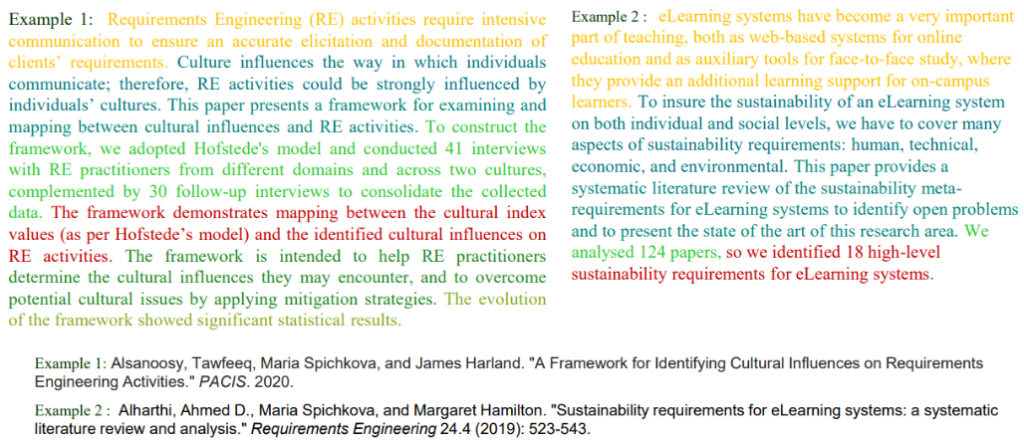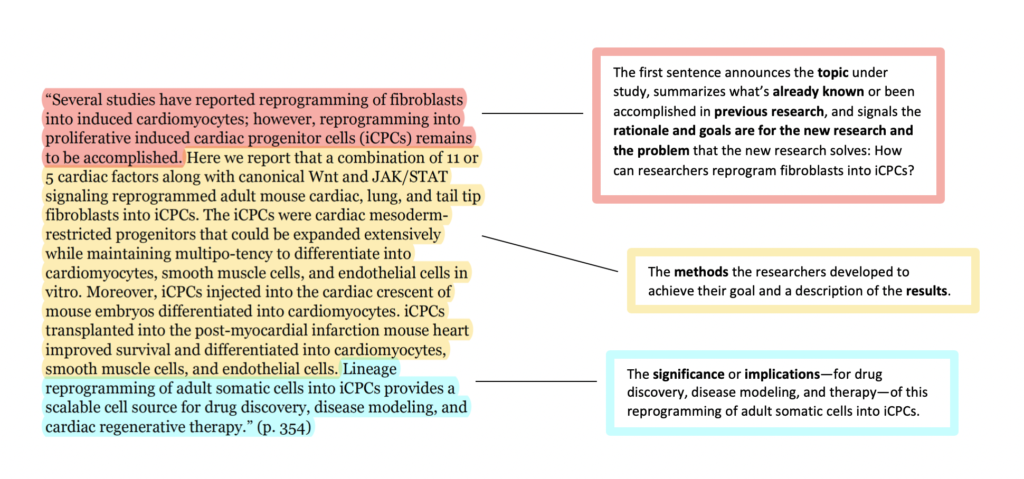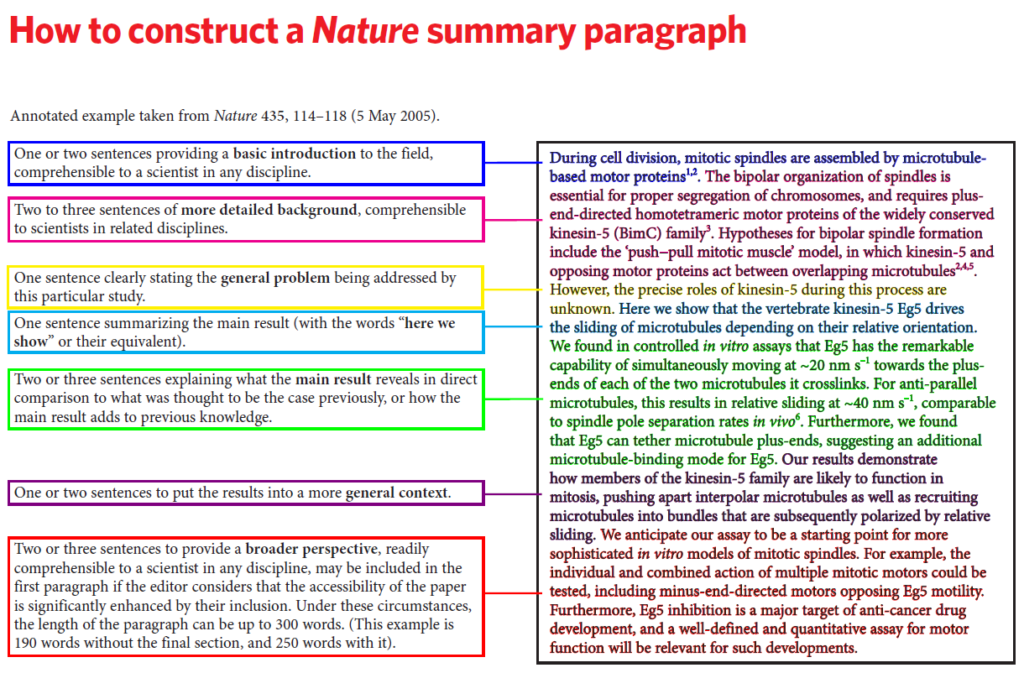There are as many types of abstracts as there are types of research documents. Writing an abstract is generally “informative”. This kind of summary communicates compressed information and includes the purpose, methods and the scope of the article. They are usually short (250 words or less) and allow the reader to decide whether to read the article.

Page contents
ToggleWrite an abstract TL;DR
Do the summary last. Reread the article, looking specifically for the main parts: objective, methods, scope, results, conclusions and recommendations. Write a first draft without looking at the original article. Edit your draft by correcting the organization, improving transitions, removing unnecessary information and words, and adding important information you omitted.
The summary must indicate:
- What is the goal/problem? (in yellow)
- Why is this important (social/industrial/scientific, etc.)? (in blue)
- How do you deal with the problem? (in green)
- Your main results
How will this contribute/benefit? (in red)
Keep in mind that the abstract is a kind of summary of the article, a kind of preface.

To do what ?
A well-written summary serves several purposes:
- a summary allows readers to quickly understand the gist or essence of your article or article, in order to decide whether to read the entire article;
- a summary prepares readers to follow the detailed information, analysis, and arguments of your full article;
- and, later, a summary helps readers remember the key points of your article.
It is also worth remembering that search engines and bibliographic databases use abstracts, along with the title, to identify key terms for indexing your published article. So, what you include in your abstract and title is crucial to helping other researchers find your paper or article.
If you are writing a summary for a course paper, your professor can give you specific guidelines on what to include and how to organize your summary. Likewise, academic journals often have specific requirements for abstracts. So, in addition to following the advice on this page, you should make sure to research and follow the guidelines for the course or journal you are writing for.
General structure
Here are the typical types of information found in most summaries:
- the context or background information of your search; the general subject under study; the precise subject of your research
- THE questions central points or problem statement that your research addresses
- what is already known about this question, what previous research has done or shown
- the main reason(s), requirement, justification, objectives of your research – Why is it important to answer these questions? Are you, for example, looking at a new topic? Why is this topic worth looking into? Are you filling a gap in previous research? Apply new methods to take a fresh look at existing ideas or data? Resolve a dispute within the literature in your field? . . .
- your research and/or analysis methods
- your main findings, results or arguments
- the meaning or implications of your conclusions or arguments.
Your summary should be understandable on its own, without requiring a reader to read your entire article. And in an abstract you usually don't cite references.
First introductory part
The introduction answers the question “What?” » It consists of approximately two to three sentences that summarize the article.
When writing the introduction, the first sentence should mention the main content of the article, while the second should be the background or context of the question.
The introduction should state the purpose of the research and define the importance of the research. If you know how write a thesis for a research paper is the part where you highlight your research objective. The researcher can do this by defining the gap in knowledge that the article aims to fill or the limitations or restrictions of previous studies. The introduction addresses the most important part of the research in the most economical way possible.
Additionally, ask yourself a few questions when writing the introduction:
- What problems does this study solve?
- What is the main knowledge gap that your study aims to fill?
- Why are the results of this study important?
The introduction also contains the third sentence, which discusses the importance of research. This statement answers the question “Why?” » This element of the summary is one of the most important aspects that attract readers in the first place.
This section details the objective of the research, or what it aims to do, in the form of a hypothesis. You can be more specific here if necessary. You should also consider writing the importance of the research in a manner appropriate to your variables and data.
Second part on methodology
This section answers the question “How?” » This part details the processes and methods used to answer the “What” questions (Introduction) and “Why” (Importance of the research) stated previously.
You should devote about three to four sentences to your section of methodology. Here you need to describe the following:
- How the research was designed
- Data (or subject) of the study
- Study setting and other variables that may have influenced the results (not required)
- How did you choose the data?
- Tools and techniques you used to arrive at your conclusion
- How the results were validated
Third part on results
The results section, also known as findings, is the culmination of the summary. This, in general terms, responds to the main thrust of the study. As such it will contain, in addition to the results, a statement of its meaning (and how it is so) and how it has changed (if at all) in relation to the hypotheses put forward in the third sentence.
Additionally, results should always be written in the past tense. Although it varies depending on the methods you used and the amount of data you generated, it should never mention anything beyond the scope of the study or what you have done. -even found.
Make sure you only report results. Interpretation should be in the next section, where you can tell the reader what the results mean and how it may affect the area of knowledge you are researching.
Part four on opening
The conclusion is the last section of the summary. It answers the question “So what?” » This section interprets what you found in the previous section and states the general implications of your results. The conclusion describes what these results mean for the long term or the area in question. It can also contain your recommendations based on your findings.
To write this section effectively, you can ask yourself a few additional questions, such as:
- Can your results be applied to other situations?
- Did the results fill the knowledge gaps described in the introduction?
- How are your results similar or different from related studies?
- Would your results lead to another hypothesis?
That said, it's easy to overgeneralize or exaggerate the implications and significance of your results. Avoid this by sticking to data the reader can actually find on paper. Describe the main conclusions, then chain them together using a rational statement.
Some examples
Here are some examples of summaries. As you can see, the abstracts do not contain all the information cited in this course, it is up to you to determine the salient points to write in the abstract.



